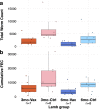Vaccine-induced time- and age-dependent mucosal immunity to gastrointestinal parasite infection
- PMID: 35798788
- PMCID: PMC9262902
- DOI: 10.1038/s41541-022-00501-0
Vaccine-induced time- and age-dependent mucosal immunity to gastrointestinal parasite infection
Abstract
Individuals vary broadly in their response to vaccination and subsequent challenge infection, with poor vaccine responders causing persistence of both infection and transmission in populations. Yet despite having substantial economic and societal impact, the immune mechanisms that underlie such variability, especially in infected tissues, remain poorly understood. Here, to characterise how antihelminthic immunity at the mucosal site of infection developed in vaccinated lambs, we inserted gastric cannulae into the abomasa of three-month- and six-month-old lambs and longitudinally analysed their local immune response during subsequent challenge infection. The vaccine induced broad changes in pre-challenge abomasal immune profiles and reduced parasite burden and egg output post-challenge, regardless of age. However, age affected how vaccinated lambs responded to infection across multiple immune pathways: adaptive immune pathways were typically age-dependent. Identification of age-dependent and age-independent protective immune pathways may help refine the formulation of vaccines, and indicate specificities of pathogen-specific immunity more generally.
© 2022. The Author(s).
Conflict of interest statement
The authors declare no competing interests.
Figures




References
Grants and funding
- BB/M012956/1/RCUK | Biotechnology and Biological Sciences Research Council (BBSRC)
- BB/M012956/1/RCUK | Biotechnology and Biological Sciences Research Council (BBSRC)
- BB/M011968/1/RCUK | Biotechnology and Biological Sciences Research Council (BBSRC)
- BB/M011968/1/RCUK | Biotechnology and Biological Sciences Research Council (BBSRC)
- BB/M011968/1/RCUK | Biotechnology and Biological Sciences Research Council (BBSRC)
LinkOut - more resources
Full Text Sources

